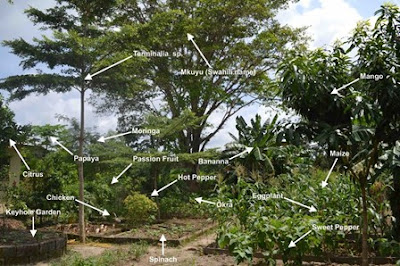PDC LESSON 2.2 DESIGN - AROUND THE HOUSE
PERMACULTURE COURSE AGRO-ECONOMY
PDC LESSON 2.2 DESIGN - AROUND THE
HOUSE
The
house needs to be sited according to the aspect that is most suited to the
property ie: considering the prevailing winds, sun etc. Planting strategically
around the house when there are problems with overheating or unwanted views
with a wind break or a micro-climate can be created to cover a multitude of
sins.
Plan
first then plant, this will make the house a more comfortable place to live in.
Planting trees to create shade where they are wanted to screen out the hot sun
and allowing the sunlight to pour in where it is desirable is the first step in
planning for climate control. You would then need to consider where from the
kitchen door you would place a herb and vegetable garden. When these are planted near the kitchen it
will be so much more user friendly to the cook than if the garden is placed
further away. You will need to look for a handy place for the worm farm or/and
the compost heap as well. Or do all your food scraps go to the chooks? If so,
the chook house needs to be close enough to the house but far away enough not
to be a nuisance.
How
about all those spaces between the garden beds? Why not grow a ground cover
instead of lawn? This will avoid mowing all those little areas of grass in
between gardens that makes the mowing such a chore. There are quite a few
useful and hardy ground covers to choose from and a favourite Permaculture
ground cover around vegetable gardens is pinto peanut. This plant is
very suitable to grow on garden paths and is also a legume, so it helps to
increase soil fertility. Pinto peanut will become a carpet like cover. It needs semi- shaded
areas and also needs adequate moisture. The pinto peanut is more
suitable to plant around raised garden beds such as tank gardens so as not to
encroach onto the garden beds. Planting a groundcover is the first step to
creating your own micro- climate.
Text from the roots, Elisabeth Ferkonia (Aus.) PDC studied with Bill Mollison,



Comments
Post a Comment